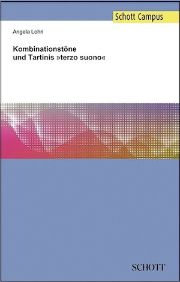Tartini's theory of the third tone
When two tones are played on the violin, a third tone is heard. In her dissertation, the Swiss musician Angela Lohri studied combination, difference and summation tones using sources from the 18th and 19th centuries.

In 1714, the 22-year-old Italian violinist and composer Giuseppe Tartini discovered that a third note ("terzo suono") could be heard when playing two notes on his violin. From 1728, he made this phenomenon a fundamental rule for the students of his school when tuning, which became known throughout Europe. He published his research in 1754 and 1767 and discussed it with Leonhard Euler, among others. Tartini reported that Plato had already known about it and interpreted it as a sign of the soul of the world: "(...) the harmony of the universe is the whole tree; music is a branch of it, but necessarily of the same nature and root, which the innate music of the human species obviously proves, since it alone is capable of the science of number. In this sense there is knowledge and nature in number, (...) and in this sense there is the possibility of discovering the tree through the branch, the whole from the part (...)"
This harmonic view of Tartini is receiving increasing attention in today's research, especially since neurological findings on the connections between the ear and brain have increased. The integer order of overtones, which is intrinsic to all sounds, is physiologically regarded as fundamental to everyday sound recognition. Over the last 300 years, researchers have continually found new ways to track down the combination, difference and summation tones.
In her dissertation, the Swiss Angela Lohri expands on the complexity and multi-layered nature of the phenomenon using primary sources with a focus on the 18th and 19th centuries and explains the differences. She returns to Tartini's holistic view: the third tone is the bass of the two tones and their common overtones, i.e. the unity in the multiplicity; the overtones in turn represent the multiplicity in the unity. To illustrate this, he composed 26 two-part Piccolo Sonata for violin without writing the bass: it would emerge by itself. Tartini defended himself against the one-sidedness of contemporary scholars and musicians and emphasized that his theory was valid for the violin. physical (the combination tones are created in the air), harmonic (see quote above) and musical-practical as a unit.
Lohri makes a significant contribution to the musical aspect: On stringed instruments without frets such as the violin, you can play two syntonic tones (with integer ratios) and control them precisely with the combination tones, as these react very clearly to even the smallest changes of the finger on the string. With the tritone, for example, you can clarify the harmonic context (is the lower or the upper tone the leading tone?), as you have two different combination tones to choose from with a subtle setting! Lohri reports on her listening experiments with various violins and strings, similar to those previously carried out by Pierre Baillot and Michelangelo Abbado. These studies also took her to Stockholm, where she was able to work even more precisely with a string machine. The problem of tempered tuning is approached philosophically by Hans Kayser and Dieter Kolk: Tolerance between idea and reality seeks a way through "all our considerations of nature and spirit" with limited scope.
I underpin my recommendation to study this book for musicians, instrument makers and as an occasion for further research with a quote from Angela Lohri: "The importance of combination tones lies ... in their effect and suitability as a method for sensitizing the perception of tone ... Their mathematical-harmonic properties tell us more about the deeper essence of music." And from Gerhard Mantel: "String players at music academies spend 70-90 percent of their practicing time on improving intonation." The printed book is very helpful for studying, which requires a lot of leafing back and forth. The missing index is advantageously replaced by a perfect search function in the electronic version.
Angela Lohri, Combination tones and Tartini's "terzo suono", 316 p., 94 illustrations and sheet music, free download, paperback € 49.99, hardcover € 55.99 Schott, Mainz 2016, ISBN 978-3-95983-079-9








